Real "flotsam and jetsam" is always exciting; what the sea washes up is diverse. And our water-related topics are just as varied here.
Enjoy reading and "collecting flotsam"...
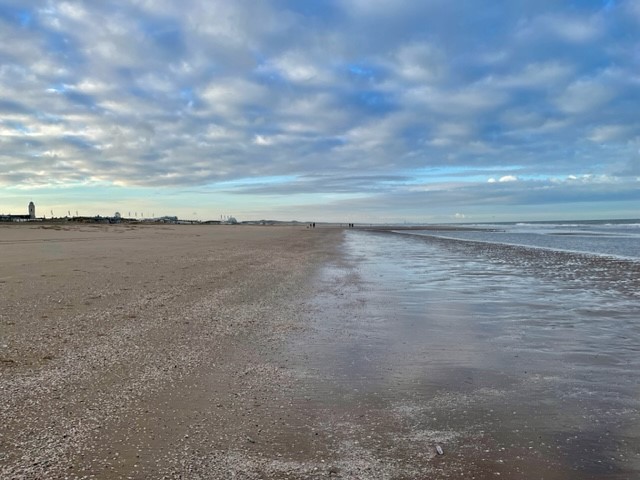
Want to take a quick stroll along the rough water before breakfast? Step out of the Hotel Noordzee and the wide, flat sandy beach awaits you; in the morning it is only shared with joggers and numerous dog walkers who are out and about early. The hotel is in the front row and has a view of the water: simply watch the sea from the breakfast room and make your first plans for the day. Marvellous!
Katwijk aan Zee is a charming coastal town in the Netherlands, known for its stunning beaches, rich history and picturesque surroundings. In addition to the incredibly wide, sandy beach, the town's positive sights include the Katwijk lighthouse, known as the 'Vuurbaak' and a characteristic landmark of the town. It was built in the 17th century and offers a great vantage point over the coast and the sea.
The historic centre of Katwijk aan Zee is rich in tradition and history. Visitors can stroll through the narrow streets, admire historic buildings and experience local life or visit the Katwijk Museum. The coastal promenade of Katwijk is ideal for strolling and offers a variety of restaurants, cafés and shops with sea views.
If you fancy a nightcap in the evening in the picturesque pedestrian zone, how about the quaint pub "In den Blauwen Bock"? This cosy, uncomplicated pub is somehow a mixture of daytime café, beer pub and in-burger bar. The speciality here is the mega-thick and delicious "Bockburger", the best way to satisfy hunger after a long day at the beach. Find out more here: www.blauwenbock.nl.
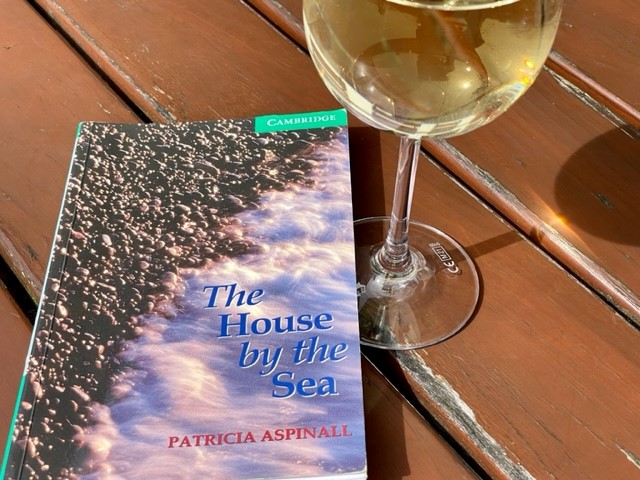
A dream come true: renovating an old house on the cliffs by the sea as a hideaway for dreamy weekends by the water. Just a few hours' drive north-east of London. But what Carl Anderson experiences here becomes his personal nightmare. His wife Linda unexpectedly goes missing and his perfect businessman's world collapses. Can his old friend John, whom he meets by chance in a pub, help him solve the mystery of the house by the water?
Published by Cambridge University Press for "English Readers", this slim volume can be read quickly in a beach chair on a day at the seaside and refreshes your English skills at the same time. This book series is an "exciting series of original fiction", written in different language levels "from starter to advanced". You can find out more about the book series at www.cambridge.org/de/cambridgeenglish/catalog/readers/cambridge-english-readers.
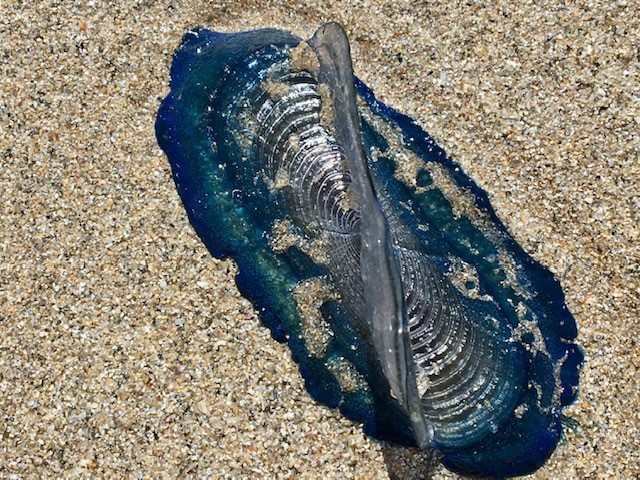
What can I find in the mudflats on the west coast of Scotland? "Velella velella", also known as the sail jellyfish or "St Peter's little ship", is a fascinating marine creature found in oceans around the world. The small light blue jellyfish is a member of the Hydrozoa, a group of cnidarians (Cnidaria) that live in the sea. This pretty sail jellyfish has a unique appearance, with an elliptical raft and a sloping, triangular sail attached above the raft.
"Velella velella" is a fascinating example of aquatic adaptations of marine organisms to their habitat. Their way of life is strongly characterised by the properties of the water in which they move.
The most remarkable characteristic of "Velella velella" is the high water content of its body, which is between 95-98%. This high water content is crucial to their ability to float in the open ocean and passively drift with the ocean currents and winds.
The elliptical raft serves as a buoyant body and is supported by a chitinous structure. This raft is light to deep blue in colour and consists of concentric air-filled chambers that keep it afloat. The mantle tissue of "Velella velella" is criss-crossed with a network of endodermal canals, which helps to maintain its buoyancy and allows it to sail on the water.
The small sail jellyfish feeds on planktonic organisms such as water fleas, copepods and krill while foraging in the water. Despite its small size and simple anatomy, it is able to catch and digest food. "Velella velella" is common in tropical and subtropical seas worldwide, and occasionally they are also found on the coasts of regions such as the British Isles and Ireland, where I discovered them in their habitat. They live on the surface of the high seas and are driven by the wind. During storms they can be washed ashore in large numbers, leading to sightings on beaches.
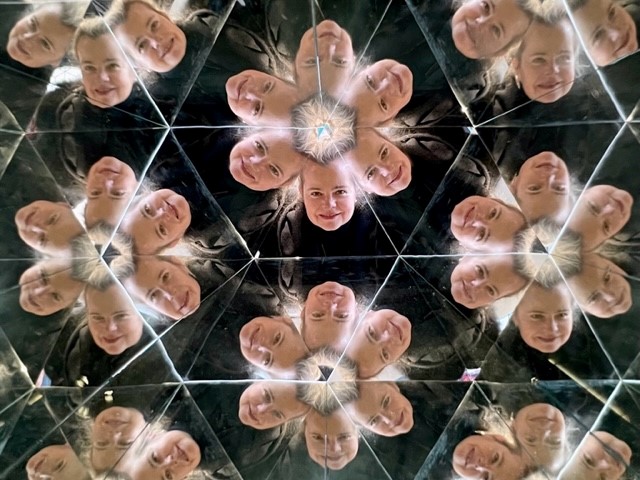
2024-01-13: The "Museum of Illusions" has an interactive museum design that fascinates visitors with optical illusions and illusions.
It offers a variety of exhibits and displays based on visual illusions, perception and geometry. Visitors can experiment in various rooms and installations and challenge their senses. Mirror tricks, perfidious geometric prints, films with colour changes, "crooked" rooms and the large rotating tunnel (in which almost every visitor loses their balance) make visitors think about the connections between perception and the processing of information in the brain. In around an hour, you will have seen and tried everything, but the impressions will stay with you for a long time: Don't relay on illusions - use your brain!, could be the motto after visiting this experience.
Unfortunately, there are no exhibits and installations in the "Museum of Illusions" in Stuttgart that deal with water or use optical illusions with water as a theme. Such water exhibits could, for example, use streams of water or reflections to create visual effects that surprise or confuse visitors. Perhaps in the future it would be possible for water to play a role in some exhibits? We, with our water team, could provide excellent advice...
Museum of Illusions, Mailänder Platz 27, 7017 in Stuttgart/Germany
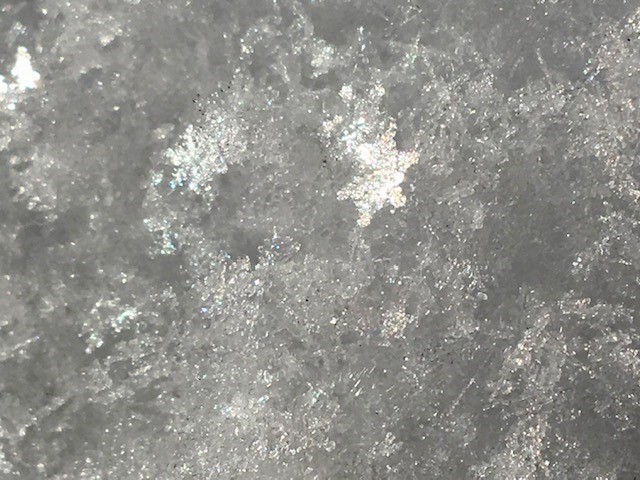
Every snowflake is a greeting from heaven.
Snowflakes form when water vapour in the atmosphere passes into the solid phase transitions and this happens in several steps.
The origin of this phenomenon lies in the existence of water vapour in the atmosphere, which is produced by evaporation from water sources on the earth's surface.
In order for the water vapour to turn into snow, the air must be cooled. This usually happens when rising air masses, which are warm and moist, cool down at higher altitudes. The cooling causes the air to reach the dew point, at which the water vapour condenses into microscopically small water droplets. These water droplets serve as nucleation centres for the formation of snowflakes and attach themselves to particles in the atmosphere.
The condensed water droplets freeze at temperatures below freezing point and form ice crystals. The specific structure and shape of the snowflake depend on various factors such as temperature and humidity. The ice crystals can continue to grow by accumulating water vapour from the surrounding air on their surface. This process can be repeated several times, resulting in more complex snowflake structures.
Finally, the full-grown snowflakes fall to the earth's surface when they have reached a sufficient size or when atmospheric conditions make this possible.
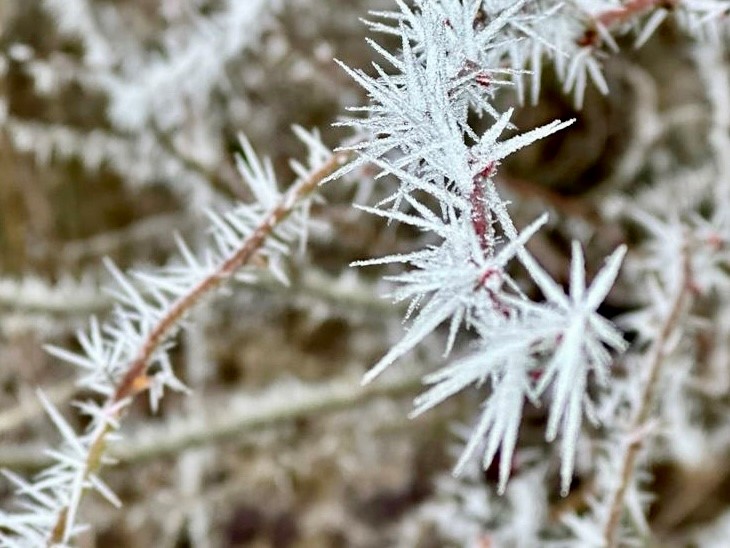
Hoar frost, unlike snowflakes, is formed through a process called resublimation, where water vapour turns directly into ice without passing through the liquid state. The formation process of hoar frost requires very cold temperatures below freezing, which typically occurs on clear nights when the air is particularly cold. Hoar frost forms on various surfaces or objects such as grasses, leaves, branches, fences and other surrounding objects. Water molecules in the air attach themselves to the surface of the cold object and form ice crystals. These crystals gradually grow by attaching more water molecules to their surface. Over time, more and more ice crystals accumulate on the surface and form a thin, shiny layer of hoar frost.
Snowflakes are formed by condensation and crystallisation of water vapour into liquid water droplets and then into ice crystals. Hoar frost, on the other hand, is formed by the direct resublimation of water vapour into ice. Snowflakes have a sixfold symmetrical shape with many branched arms and can appear in various shapes and patterns. Hoar frost forms a thin, flat layer on surfaces and usually has a less complex structure.
Snowflakes fall from the atmosphere onto the earth's surface, while hoar frost is formed on surfaces such as grasses, leaves and fences.
Overall, both snowflakes and hoar frost are amazing examples of the complex interaction between water and the atmospheric conditions that lead to their formation. Each of these phenomena displays its unique beauty and science based on the fundamental properties of water.
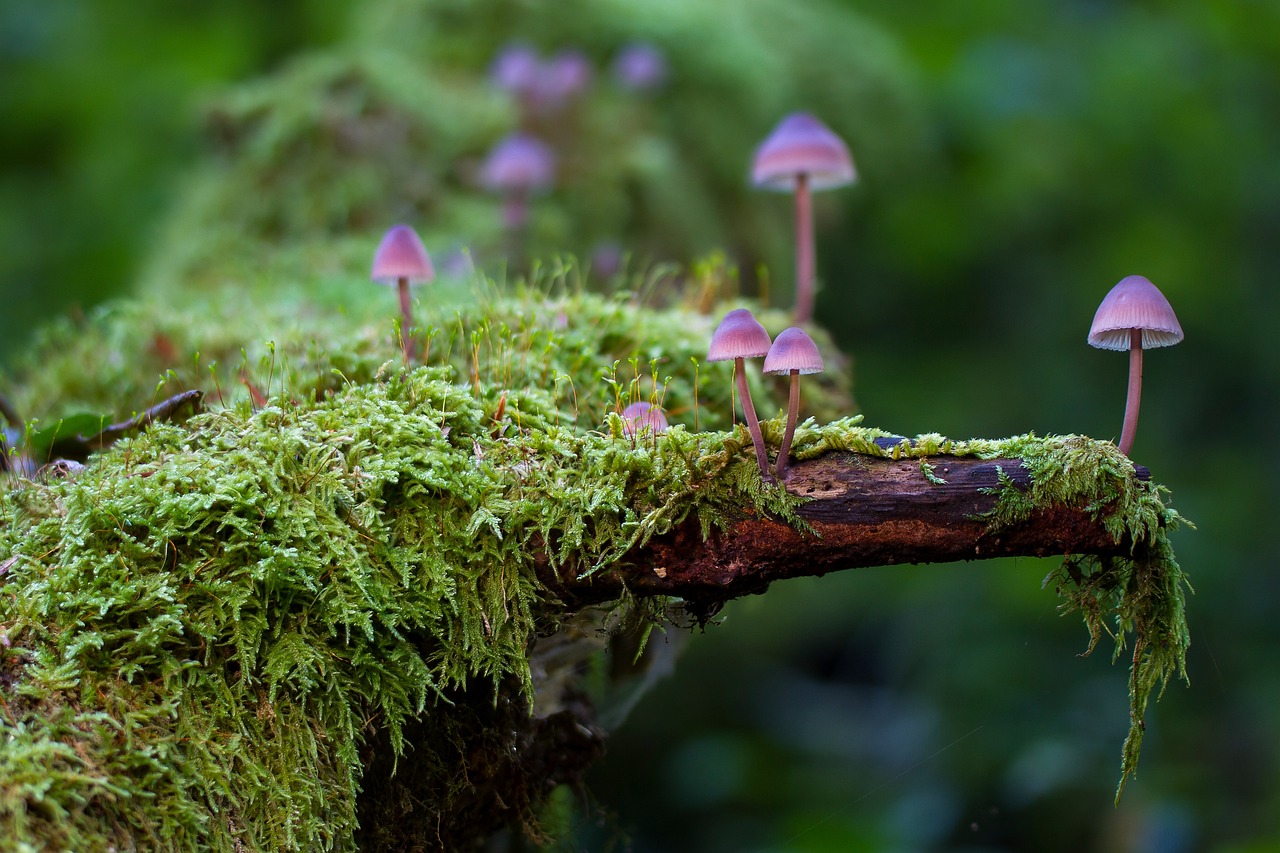
Water-storing forest gardens instead of stone gardens of horror - a new trend is focusing on greening in small spaces. Forest gardens are deliberately planted gardens modeled on the forest. Seemingly chaotic (you will look in vain for an English lawn), plant levels of different heights are planted - from ground cover plants to perennials and herbs to shrubs and bushes, with smaller and larger trees providing protection and shade for the lower plant levels. A reservoir of moisture and water in an urban space.
When planning a woodland garden, the first step is to take a very close look at the planned location of the garden. Is it more of a shade garden? Then completely different plants, shrubs and trees are selected than for a sun garden. Everything has to be coordinated just like in a real forest, even if a "real forest" always looks a bit chaotic to the untrained eye. It is not! Forest gardens are deliberately planned by landscape gardeners and, for example, permaculture designers.
Forest gardens are small ecosystems and they improve the air quality, microclimate and water retention in their surroundings. In the city and in the countryside. Like a real forest, forest gardens store moisture and lots of water - and they enable biodiversity in the smallest of spaces.
Forest gardens are also an exciting subject of scientific research and funding: the project "Urban Forest Gardens: Perennial, Multi-layered, Multifunctional" is funded by the Federal Agency for Nature Conservation with funds from the Federal Ministry for the Environment, Nature Conservation, Nuclear Safety and Consumer Protection (Federal Agency for Nature Conservation) as part of the Federal Biological Diversity Program.
In this 6-year funded project, a total of three new forest gardens will be created in urban areas in Berlin and Kassel (from 2021). In addition, the maintenance and operation of the gardens is to be made possible by a joint operation. In this way, forest gardens will become exemplary places for environmental education and research.
More information at: urbane-waldgaerten.de oder derwaldgarten.de.
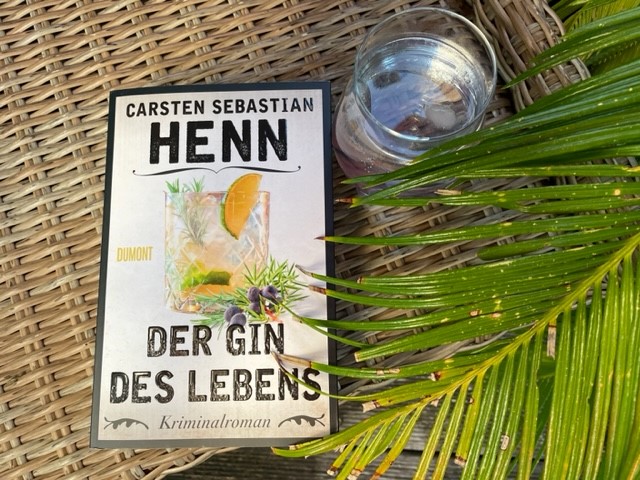
This crime novel gets going slowly, very slowly - like Bene's father's green vintage Jaguar limousine. As a second-generation classic car mechanic, Bene searches for his late father Alexander's legacy after losing his own workshop. A bottle of gin is Bene's only material legacy, apart from numerous memories. But the recipe for this exceptional gin should be worth its weight in gold, he thinks. As good as this gin in the old brown apothecary bottle tastes. Bene sets off on a search for clues, which takes him from tranquil southern Germany to the rugged gin distillery town of Plymouth. Here in the mild harbor town, he meets the tough Cathy and her quaint Bed & Breakfast, where Bene's father used to stay when visiting the classic car fairs in Plymouth. I wonder why? The walls of Cathy's reading room are papered with recipes, drawings and information about gin - and soon the two of them are not only connected by their interest in gin, but perhaps even more....
Main topic: Everything revolves around the distillation of gin, the best recipes and the preparation of gin enjoyment (no tonic water, please!) in this thriller. And the right recipe for the crystal-clear to bluish shimmering alcohol also seems to be worth a murder. A well-known homeless man in Plymouth is found dead: in Cathy's garden behind her bed and breakfast, of all places!
The gin recipe: the reader is left wondering what goes into this exceptionally good gin from Plymouth, the old naval base? What makes it taste so special? It's the special botanicals: Juniper berries, coriander seeds, zircon and orange peel and a little secret.
Surprisingly, no importance is attached to water as the basis for alcohol in crime fiction, which surprised us greatly. Just think of the various types of beer on the market, which are well aware of their water sources, often even attribute the taste of their beer to pure spring water and are happy to mention these sources in their public relations work.
Nevertheless, you learn a lot about the production of gin in this book; the author Carsten Sebastian Henn is an expert in culinary crime novels.
Our favorite parts of the book are the quotes about gin before each chapter. "Gin has saved more English men's lives than all the doctors in the Empire," Winston Churchill is quoted before chapter nine (page 249). Readers smile and sip the well-chilled gin - and do so much more consciously and with more mindfulness than before reading the book. That's for sure.
Culinary Gin Journey from the Dumont publishing house for €16.00
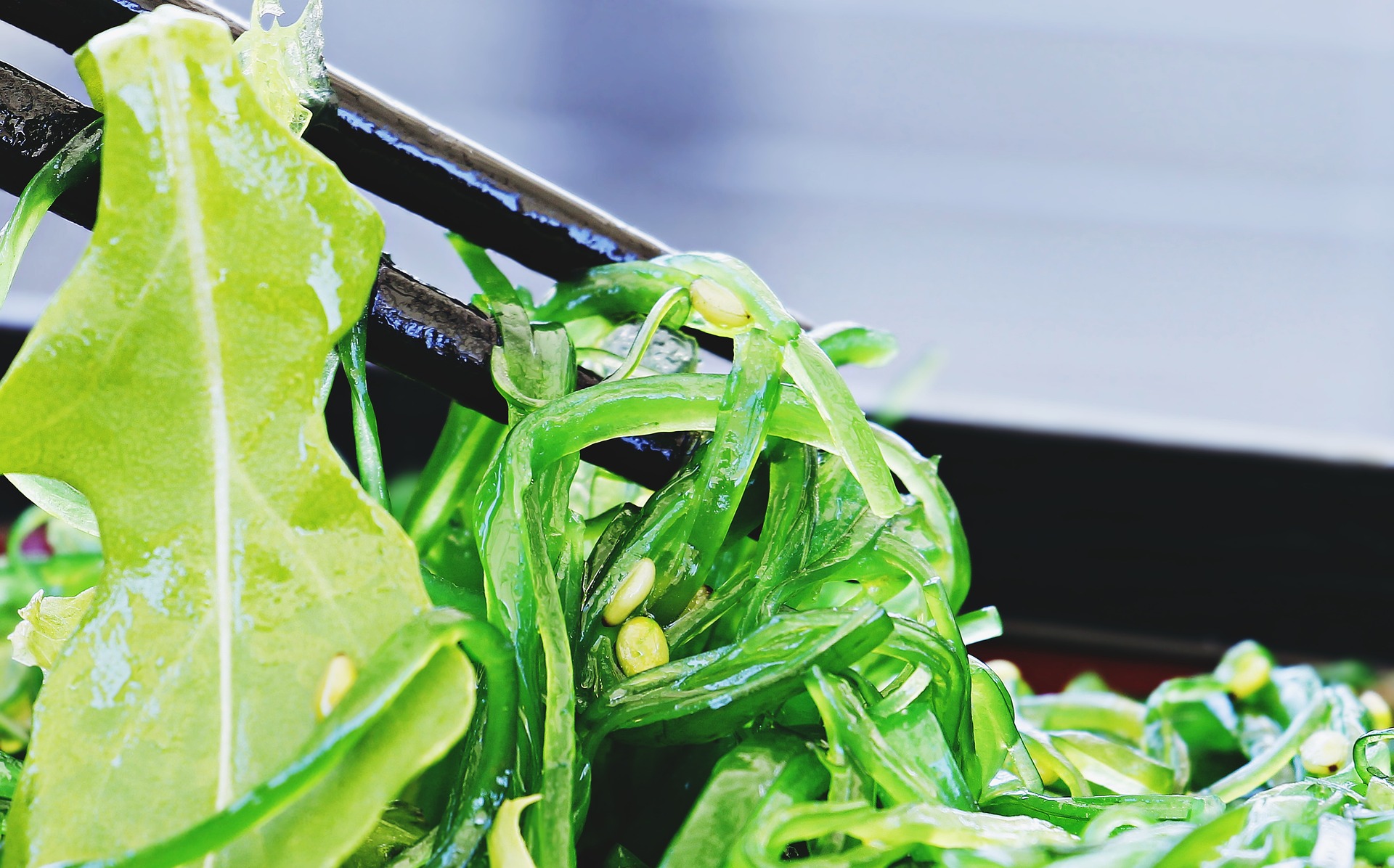
New ideas are needed if we want to feed around 10 billion people on Earth by 2050. Protein-rich and sustainable food sources are being sought. There are many resources lying dormant in the ocean that we have not yet even noticed as food. Sugar kelp, for example. You can recognise it by its shiny brown colour. It grows on buoys and ropes in the water and takes about six months to harvest. Then its arms can grow up to 2 m long in the water. The algae need neither fertiliser nor pesticides, neither fresh water nor soil. Heat waves and insect plagues cannot harm the underwater farms either. And the large farms in the sea also form a temporary water biotope for many creatures in the sea, such as small fish that live in the sugar kelp arms.
In aquacultures, the species Alaria esculenta and Himanthalia elongata are currently preferred. And there are more and more professional farms in the sea. For example, the algae farms of the Norwegian start-up "Seaweed Solutions" near Trondheim (http://www.seaweedsolutions.com ). The biomass of all algae in the oceans is about nine times greater than that of all plants on land. Algae bind huge amounts of the greenhouse gas CO² and form oxygen at the same time. They are easy to grow on underwater farms if you know how - and they can be processed in many ways. Here in Germany, algae are still rarely found on our plates. We know them as a green-gloppy garnish for sushi. However, it has been used for a long time, for example as a binding agent in pudding and yoghurt or as a stabiliser in cheese and margarine.
A start-up from Berlin wants to expand these applications: "Betta F!sh" and sister company "Oceanfruit" take the algae from Trondheim, Norway. They use them for vegan alternative spreads & co. Conventional meat or fish substitutes usually come from pea or soy proteins and thus from environmentally harmful monocultures. Algae are much more sustainable. And so the clever food designers develop vegan sea bread spreads, tuna paste without tuna and sea-flavoured pizza. The new foods from the water are supposed to be tasty AND healthy. Some species even contain more protein than meat and more calcium than milk. Seaweed is particularly rich in omega fatty acids, micronutrients (magnesium, iron, calcium, iodine) and vitamins (A, B, C). They contain natural iodine and dietary fibre. New products made from algae, so-called impact food, also have a positive effect on the oceans: tuna and by-catch do not end up in fishing nets, but are simply left alone. The populations and shoals in the sea can recover.
Algae are a raw material with a future, because they grow faster in the water than any land plant. There are about 400,000 different species of algae, 650 of which are currently used as a food source for humans worldwide. So should we shift some of our food production to the oceans? Tasty product tips and information on how to get started with algae food that has a good impact on protecting the oceans can be found here at bettafish.co/de and at oceanfruit.de.
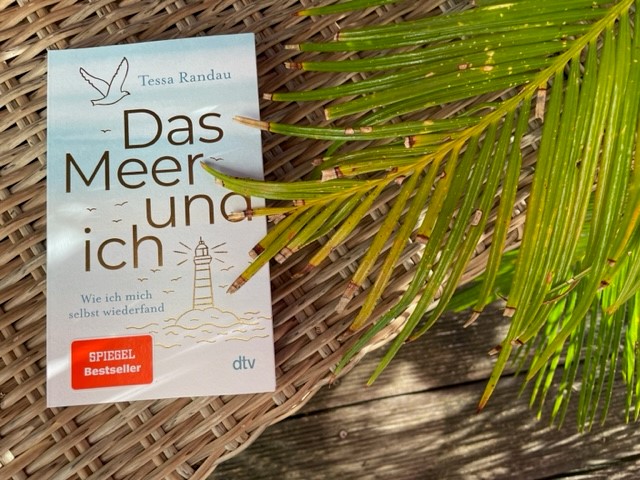
Yes, we all have crises, some of them even existential. But what about the "quiet crises" that hardly announce themselves and yet paralyse us in our activity every day? This is how the protagonist of the book feels paralysed when she has to go on the desired holiday with her friends on a German holiday island alone, because her friend Isa has an important professional project that interferes with her holiday plans at short notice. What to do with the free time at the beach - while her husband and two almost grown-up children rock the daily routine at home alone? Am I still needed at all? asks the protagonist of the slim 171-page volume. Then she finds a message in a bottle in the sea and ponders about the author of the message. This is by no means a new literary motif; we are reminded of Nicholas Sparks' bestseller "Far as the Sea". But in the end, this message in a bottle from the waves leads to an encounter with the self-confident Lene, a somewhat freakish-looking, self-contained New Islander at first glance, from whom the protagonist can take a few more slices of her life experience.
Who am I and where do I want to go? - Questions that can be clarified especially wonderfully by the sea during a meditative walk on the beach. And so the purifying and clarifying effect of water plays an important role in this slim narrative. A meaning-seeking parable worth reading with water and waves that conjures up a bit of sea and beach holiday on our couch. And makes us think about the profound things in life - but not too deeply, because that is not what the language and presentation of the booklet are meant for. It's more of a teaser to the themes of the middle-age life section. The protagonist of the book, “The Sea and I”, ultimately finds her perfect 45th birthday and a new exciting life by the water... The sea and the cleansing power of water are important building blocks for this narrative - and triggers for something new.... More about the German author at www.tessarandau.de.
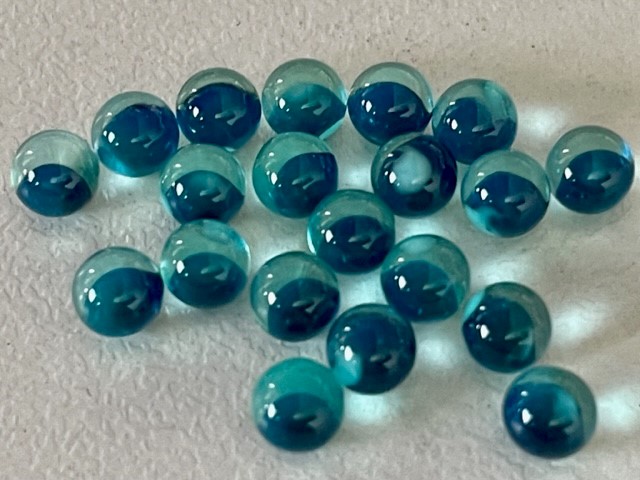
These little gooey granules, these granules that can look like large sugar crystals, could become the water supply and irrigation of the future? The new hydrogels are made from lignin, a wood raw material, among other things. The granulate is added to the plants in the root ball area and stores an enormous amount of water. The plants can then suck the nourishing water out of the hydrogels as needed, thus reducing the need for external irrigation. This saves labour and valuable water resources. Mixed with soils, the hydrogel can absorb up to 95 per cent of incoming water, saving up to 40 per cent on irrigation. The use of hydrogel could change agriculture worldwide. Even soils that were previously quite inhospitable, such as sandy soils, could be cultivated with it. Up to now, three quarters of the world's farmers have been completely dependent on rainfall. However, global warming is putting their livelihoods at great risk due to irregular rainfall patterns, droughts, desertification and loss of arable land. Hydrogels could enable some independence from weather events and water demand in agriculture because they can store water for long periods.
There are various methods of producing these hydrogels. The wood-based variant is not only used to irrigate plants in agriculture, but also to fertilise and improve soil quality at the same time. The Tulln research team around Gibson Nyanhongo (chemistry professor and head of the Biomaterial Technology research group) developed this. Nyanhongo and his team invented a special hydrogel that can be made solely from leftover untreated wood. Almost "organic", so to speak. It is said to be suitable for the field in the countryside as well as for the vegetable patch in the city. It can also be used in desert areas. Until now, however, hydrogels have mostly been made of plastics. In general, hydrogels are not really new; they are also used, for example, in nappies or in medicine.
The water-storing granules are worked into the soil like fertiliser or seed. If water is added to it or if it rains, it turns into a slippery but dimensionally stable water-hungry gel in the soil. Like a sponge, the hydrogel not only binds the coveted water in the soil, it is also supposed to absorb nutrients. Water and nutrients benefit the roots of the plants. The lifespan of hydrogels with this application is currently five to ten years. It then gradually decomposes into fertilising humus - and water.
These water storage granules are now offered by various hydrogel companies for horticulture and agriculture, including:
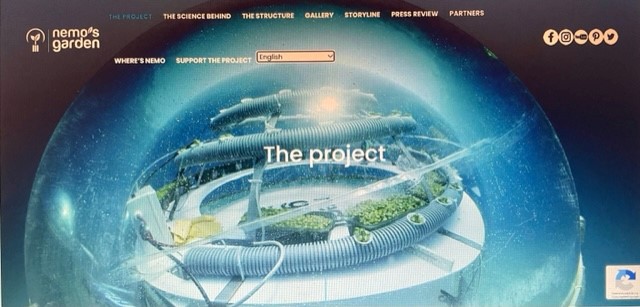
Not far from the Ligurian beach, at a depth of 6 to 10 m below the surface of the sea, a daring experiment is being launched: Nemo's Garden. These are spherical greenhouse domes made of Plexiglas, anchored on stilts on the seabed under water. Inside the underwater domes is an air bubble. Inside, the diving gardeners can briefly remove their oxygen masks and observe the plants in their pots. Many small sensors monitor the growth phases of the seedlings and shoots in the sea. Down here there is no need to water, because the sea all around is very warm, so the seawater evaporates at the surface in these plexiglass spheres and then condenses on the plexiglass walls. From there it is collected in a container and pumped to the plants in the various plant containers.
The plants also get enough light under the sea, because up to 70 % of sunlight still reaches the Plexiglas spheres below the water surface. Pesticides are unnecessary under water, because there are no plant pests here. So everything is organic.
The plant pots are all numbered and monitored daily. The diving researchers have now experimented with more than 150 plant species under water. Herbs like thyme, lemon balm and oregano grow well below sea level - protected in the transparent domes; cucumbers and tomato plants also do well in the underwater greenhouse. The whole thing is monitored from the beach by a monitoring station that records all relevant data underwater, such as humidity, oxygen content and temperature. A biologist monitors the small Plexiglas houses under water and dives down to them every day; and there is even a livestream for those interested directly in Nemo's Garden. Solar power and wind energy are of course used for the direct broadcast from the biosphere.
This unique concept is the brainchild of Sergio Gambarini. In 2012, he combined two of his passions: horticulture and diving. The result was an underwater agricultural paradise called "Nemo's Garden".
So far, the effort and costs for underwater agriculture are still high, to be sure, in order to harvest his favourite plant, basil, on the nutrient substrate under the surface of the water. And the concept is not yet really scalable, but universities and institutes are interested in Nemo's Garden and are using the underwater greenhouses for scientific purposes. Important findings for a possible agriculture from the sea...?
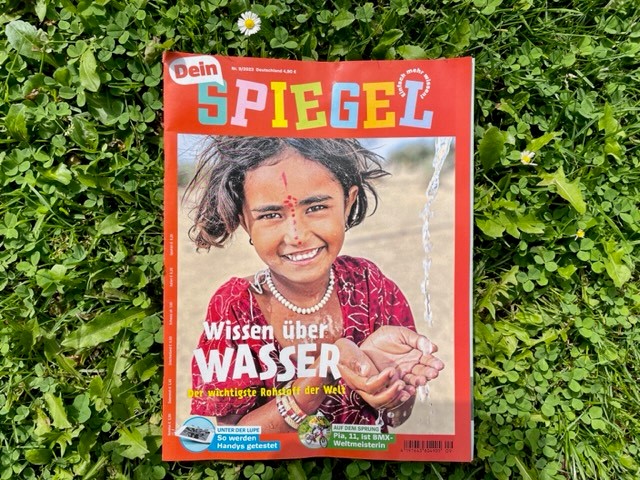
Cover story on water: in its 9-2023 issue, "Dein Spiegel" (a magazine from Der Spiegel) writes about the world's most important raw material. The cover story "Too much, too little, too dirty - water determines life on earth" is ten pages long. Every human being, every animal, every plant needs it. But our drinking water is under threat" and provides well-prepared knowledge about water for schoolchildren. It explains not only the basics like the water cycle and how much "virtual water" is hidden in the production of our food, i.e. the water that is needed to ripen a banana or a tomato. Or the water that is used to produce 250 grams of beef. 1260 liters are supposed to be "in" a pizza Margherita - that inspires kids to ask questions and discuss! Articles about a water-friendly city and why not all wastewater is the same round off the reading fun, along with many other entertaining and interesting topics. More info at www.deinspiegel.de.
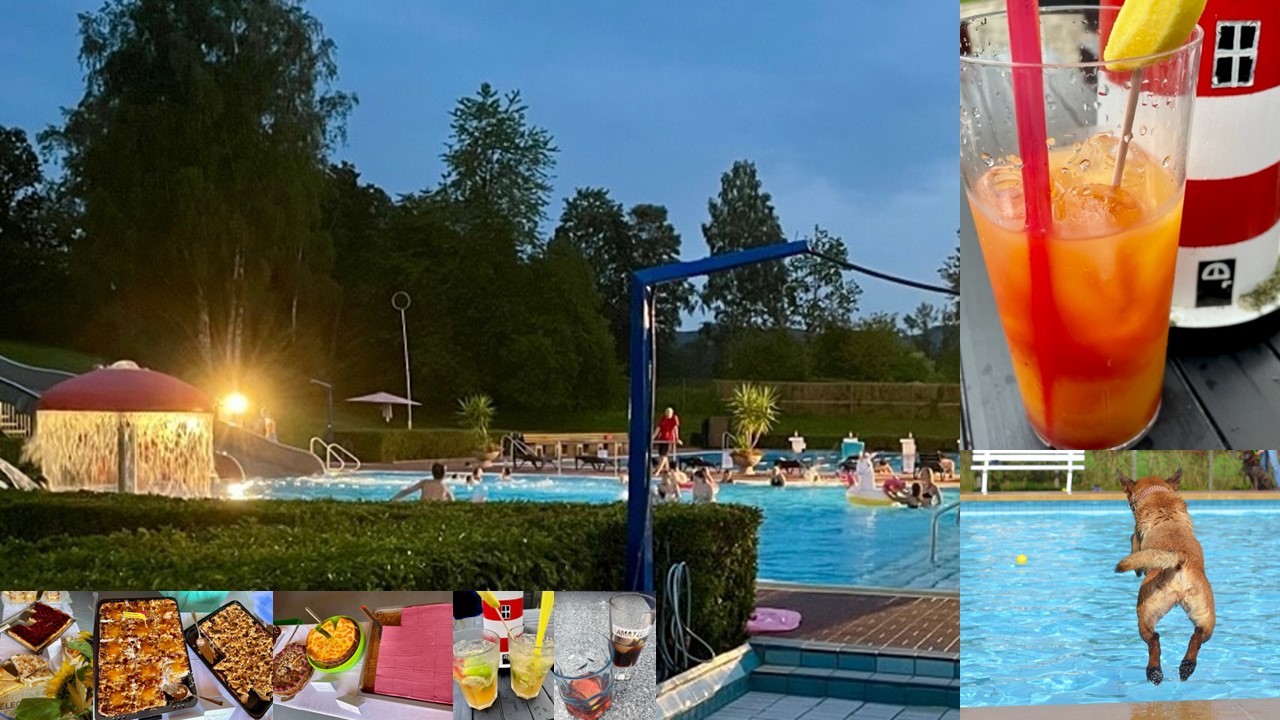
Money is spent on everything, but outdoor pools in the countryside have to close. So that kids & co. can continue to have their swimming fun and also in rural areas have a meaningful sports and leisure offer during the summer vacations, active citizens get involved in voluntary associations for the preservation of the regional, small swimming pools. Painting and cleaning at the start of the season, maintaining the green areas and cashiering: without the volunteers, the fun of swimming would have long since ceased. City/municipalities and volunteer clubs work hand in hand. Club fees and highlights of the bathing season - the colorful swimming pool festival - ensure financial support. The adventure event "Swimming until midnight" as well as culinary delicacies such as homemade cakes for the coffee buffet, an evening cocktail bar or the sale of grilled sausages all benefit the maintenance of the swimming pool on a 1:1 basis. We (as a small research group "World in a Drop") are sponsors for the first time in 2023 and hope that many will follow our voluntary and/or financial commitment. Even in rural regions, cultural and sports facilities must be maintained and cared for: with cleverly thought-out water management and active treatment, as well as the use of solar systems for water heating, they also become justifiable for the ecological and water balance.
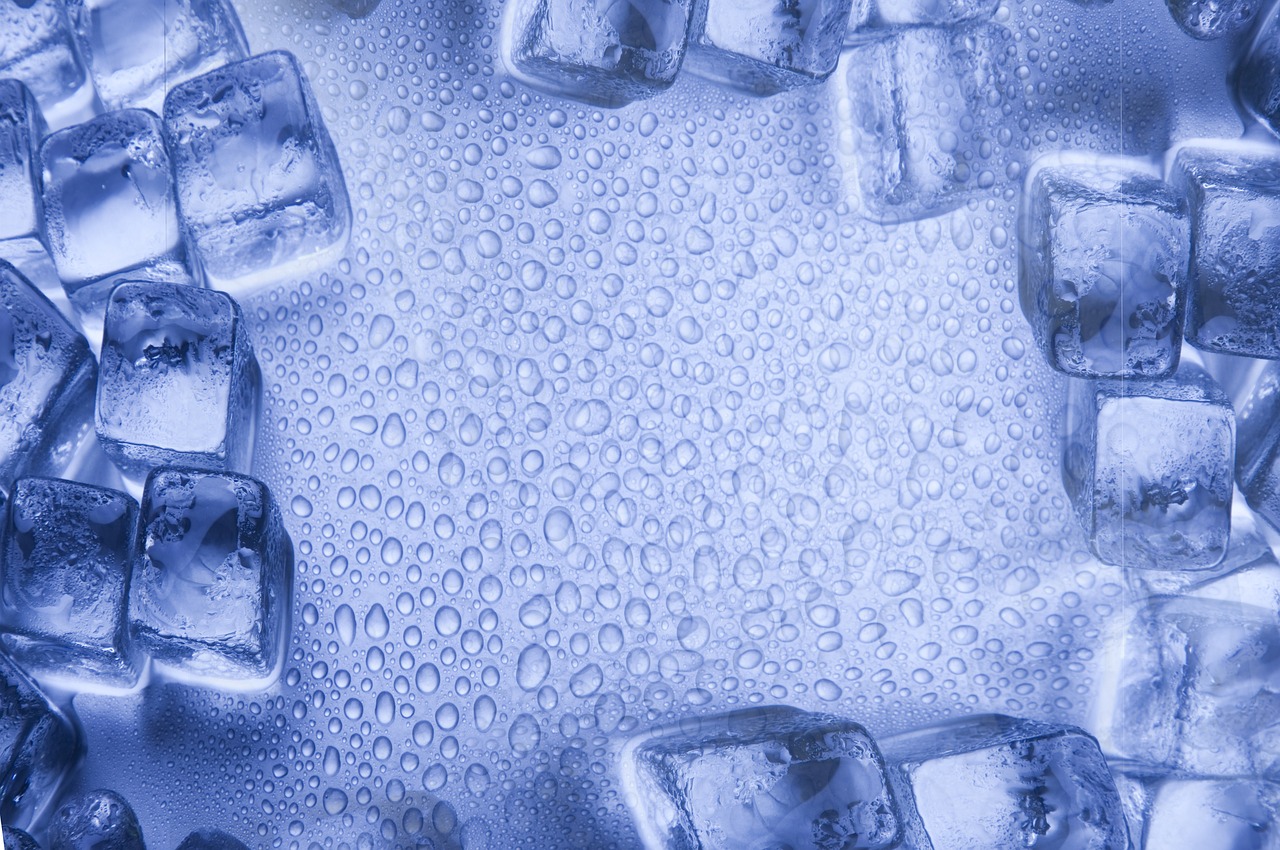
Have you already seen it? The exciting physical state of water, light ice, is the basis for an application newly discovered in the first gyms in America: ice bathtubs filled to the top with clinking ice cubes. This has nothing to do with an ice bucket challenge. Under supervision, you can slip into the cool bucket of water here for a maximum of 3 minutes after your workout: this is supposed to relax the muscles and at the same time you are wide awake for the rest of the day due to the cold shock from the ice-cold water. With the right breathing technique, which calms the organism and helps it to get used to the cold water, the ice-cold bath in the ice cube water should be endurable and even healthy.
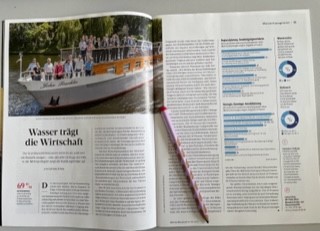
Berlin is experiencing its fifth drought summer in a row and groundwater resources are becoming scarce. This also has consequences for the business location of the metropolitan region. In order to minimise the negative effects of climatic and structural changes on the economy, the four chambers of commerce and industry from Berlin, Potsdam, Cottbus and East Brandenburg want to work together on the topic of water use. As an initiated company survey in the region shows, a third of the companies already actively involve employees in water-saving measures and a quarter have already made optimisations in heating, sanitation and air conditioning. The results of the joint survey by the Chambers of Industry and Commerce and the Association of Municipal Enterprises (VKU) also revealed that greater awareness and investment promotion for water conservation is needed to ensure a secure supply of drinking water and economic water use in the future. To promote exchange and networking between academia and businesses, the IHK Berlin and the HWR offer an Innovation Challenge for efficient water management: university teams, institutes and start-ups brainstorm together with businesses to develop future-oriented solutions for water-saving measures. Contact: Larissa Scheu, IHK Public Affairs Manager Energy and Climate Protection Policy, IHK Berlin. You can find the entire article in the IHK magazine 7/8-2023 or online.
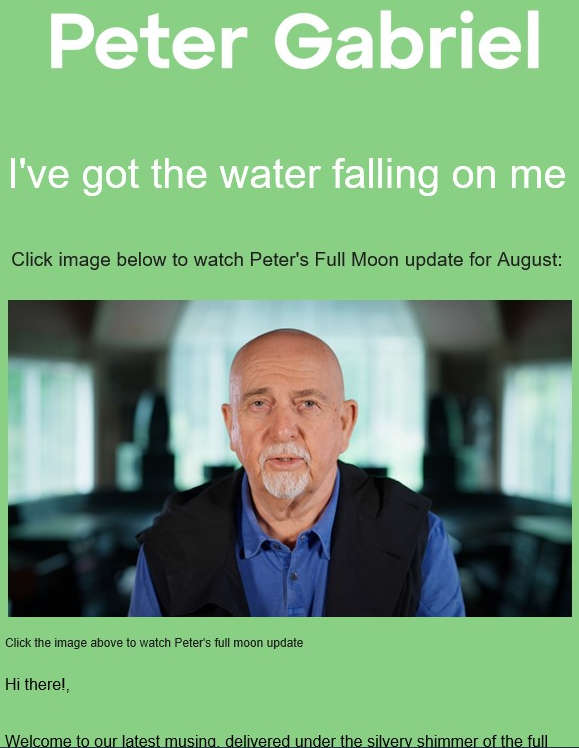
Water has inspired artists since the dawn of human culture. One of the most influential musicians in music history, combining elements of rock, pop, world music and electronic sound experiments, is Peter Gabriel. He wrote songs such as Red Rain, Mercy Street and Here Comes the Flood - and these have to do directly or symbolically with the effect or powerful properties of water. Peter Gabriel's profound song lyrics also deal with man's position in his world, our connection to nature, and the manifold possibilities of communication within it. His quote aptly expresses this:
"In some ways I do think we are part of everything and we probably have means to connect and communicate with everything that we often shut off. We only want to see and listen to the things that seem important and relevant to us and shut out the noise of everything else when, probably, hidden in that noise there are all sorts of things that can help us realize our place in this future world." Feel free to follow him with his monthly newsletter: petergabriel.com.
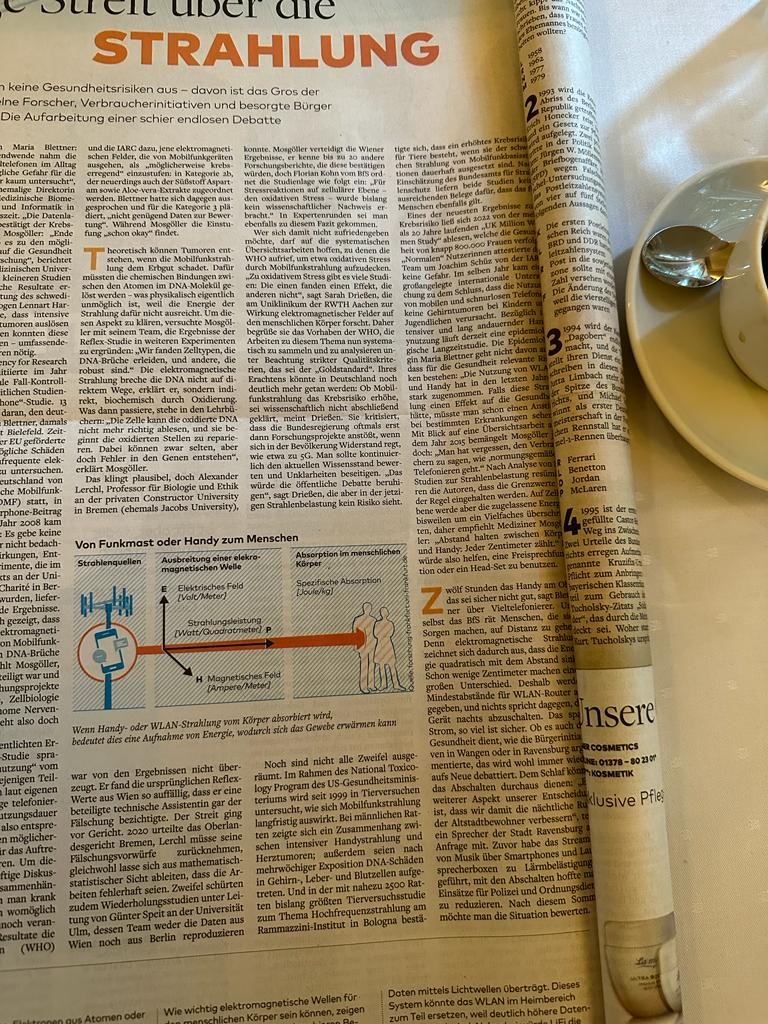
How harmful are the radiations of mobile phone networks and WLAN for the human organism and nature? An ever smouldering debate between electrosensitive people and e.g. the Federal Office for Radiation Protection (Bfs) has been rekindled, as "Die Welt am Sonntag" reported in its article "Der ewige Streit über die Strahlung" on 6.8.2023: the city of Wangen in Upper Swabia has switched off parts of the public WLAN network at night between 11 p.m. and 5 a.m., street by street, because the citizens' initiative "Bündnis Verantwortungsvoller Mobilfunk Deutschland" (Alliance for Responsible Mobile Communications in Germany) suggested to "relieve" electrosensitive people from the nightly radiation of the network. Unfortunately, only the thermal effects of mobile radio have been scientifically proven so far, i.e. that certain regions in the head are heated differently when using a mobile phone. A direct conclusion from this heating of the tissue to the excitation for the development of brain tumours has not yet been scientifically proven. More studies are therefore needed. We in the research "World in a Drop" can make the effects of mobile phone radiation, X-rays & Co. visible in the (water) drops under the dark field microscope. Already after a three-minute (wordless) phone call with a mobile phone, the inner droplet structure in a human saliva droplet changes. This change occurs in every human being and regenerates in a few minutes or only in hours, depending on the state of health of the person. What is interesting in our studies is that mobile phone radiation affects the human body and body water such as saliva, blood, urine, cerebrospinal fluid, etc., independently of thermal heating. The human body consists of up to 70% water, i.e. our corpus reacts sensitively to these influences. More info on this free of charge on these research pages at Frequencies and Lettuce + mobile phone.
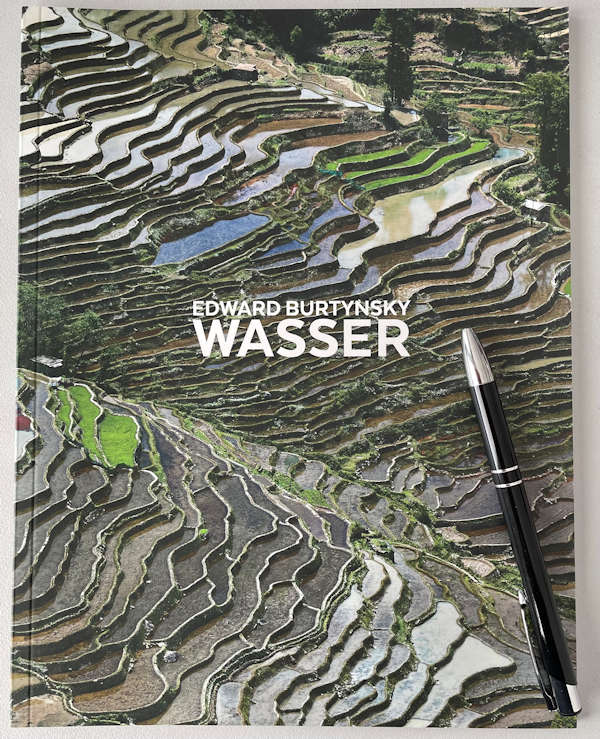
Water shapes our existence as well as the face of the earth in rivers, lakes, seas and oceans.
Water is a substance capable of change - this applies not only to its aggregate states, but also to its ability to shape and influence the earth's surface.
More than 70% of the earth's surface is covered by water. Around 1.4 billion cubic kilometres of water are on earth, of which around 3% is available to us as usable fresh water.
Artists love the creative power of water and capture it in impressive photographs. For example, the Canadian artist Edward Burtynsky. He is one of Canada's most respected photographers, and his photographic representations are represented in the collections of over 60 major museums worldwide. His photographs have won numerous awards. Very apt is his quote at the beginning of his photo book "Water": "I realised that we are really dependent on water as opposed to oil. Without water we die." You can find his small book of photos in our own Water Online Shop. Or the artist Bernhard Edmaier, who is showing his photos in the exhibition "Water - How it shapes our Earth" in the Natural History Museum in Reutlingen until 22.10.2023, deals with the shaping effect of water. In his photos, mainly the geological formations of water on earth are sensitively and powerfully documented. Be inspired by the works of art created by water or its use in global industrial landscapes.
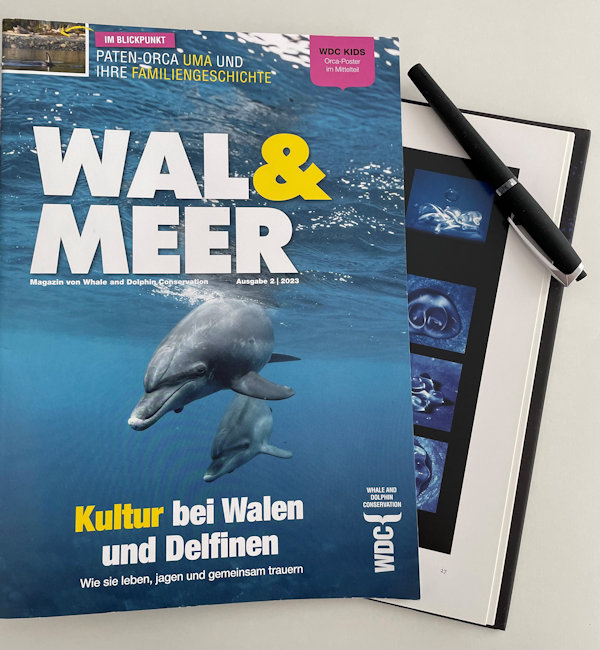
For many years we have been supporting the "Whale and Dolphin Conservation gGmbH" in Munich (WDC) by sponsoring a dolphin (his name is Speedy).
In this way, we help to support the conservation of the marine ecosystem.
Among other things, the WDC works to ensure that humpback whales, pilot whales and all dolphin species such as orcas can continue their lives in the world's oceans in a protected way. Whales live in complex social groups and form close bonds with their family members. These fascinating behaviours, among others, are part of the research. You can read about all this in the climate-neutral printed member magazine or directly on the website at www.whales.org.
Here in the "inland" of Stuttgart, the sea seems far away from us; but the seas, oceans and also rivers and lakes make up more than 70 % of the earth's surface,
i.e. even if we (unfortunately) cannot see the sea directly, we are firmly connected to it in the areas of climate, food and transport. And even the rivers - like the Neckar near Stuttgart - lead into the sea at some point, as is well known...
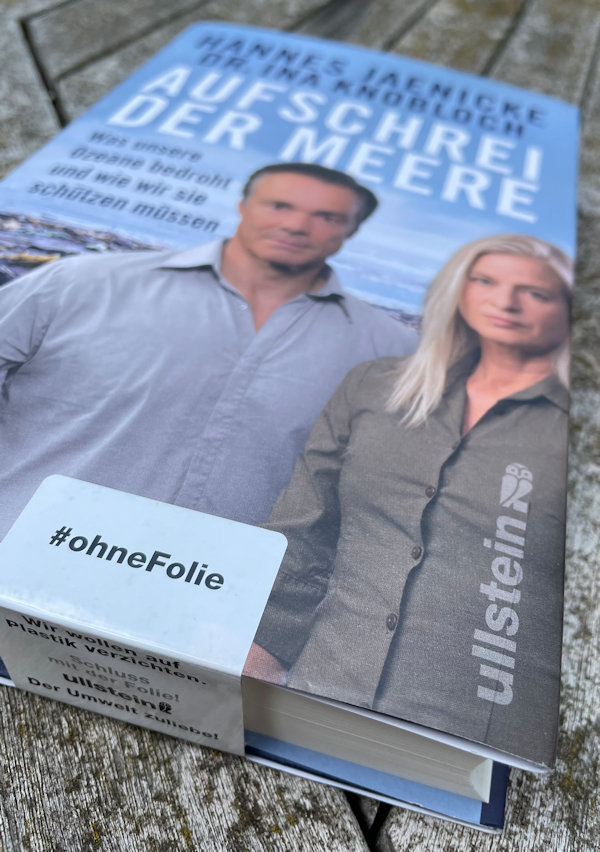
Everyone would like to read a new book that has not yet been coughed into or "grasped". After all, a book is a personal object that you carry with you wherever you go during the reading process: sofa, bed, favourite place....
Until now, bookshops and mail-order companies offered protection in the form of a welded plastic cover, which at best ended up in the yellow bag after purchase.
But this is outdated: in shipping, we use blue "tissue paper" to protect our book "The Secrets of Water", in which each book is lovingly wrapped before it goes through the post.
And big publishing houses that don't afford this manufacturing work like we do rely on small stickers that deny unauthorised persons access to the inside of the book.
Only the buyer removes the small label (see photo), which is a minimum of the protective film used in the past. The publishing house Ullstein is setting a good example! May many more publishers follow!